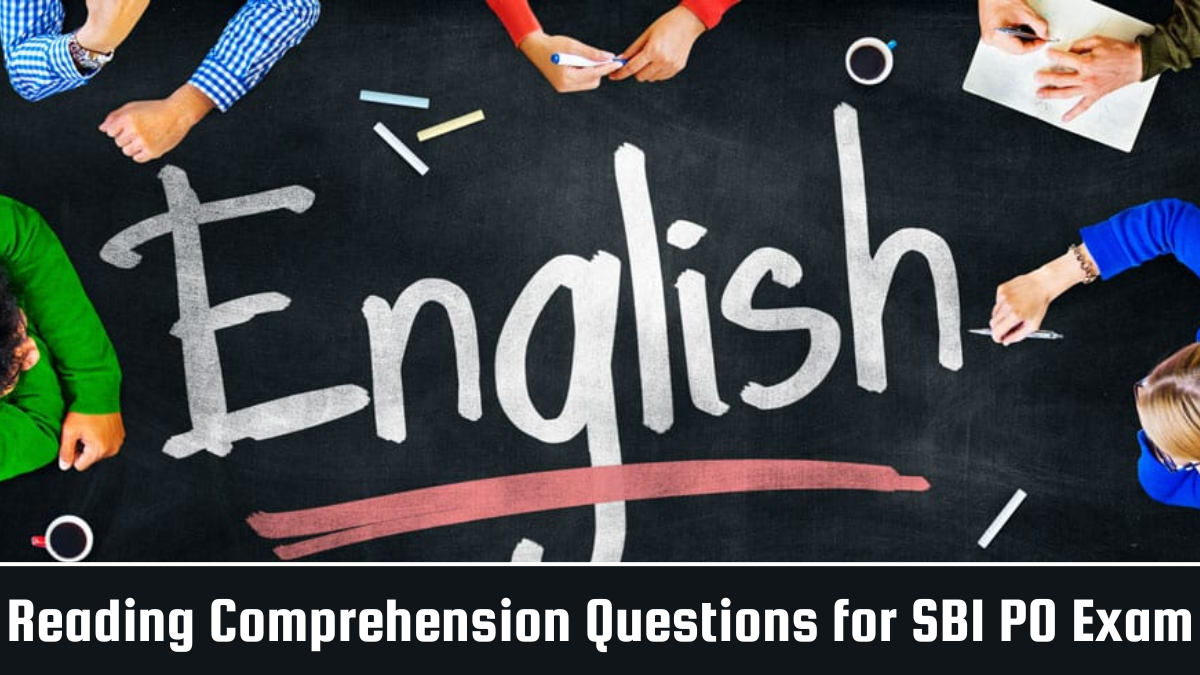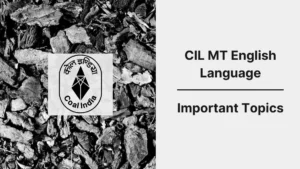Table of Contents
Reading Comprehension is a crucial part of the SBI PO Mains Exam, testing a candidate’s ability to understand, interpret, and analyse complex passages. These questions demand a strong grasp of English along with sharp critical thinking skills. Mastering RCs can significantly boost your overall score in the English Language section. Consistent practice and the right approach are essential to tackle both factual and inference-based questions effectively.
Reading Comprehension for SBI PO Mains Exam
In the SBI PO Mains Exam, Reading Comprehension passages are usually drawn from diverse topics such as economics, environment, social issues, or current affairs. The questions may include vocabulary, tone of the passage, central idea, and inference-based queries. To excel in this section, candidates should develop a habit of reading editorials, opinion pieces, and reports from reputed sources. Regular practice not only improves reading speed but also enhances the ability to spot relevant information quickly.
Reading Comprehension Questions for SBI PO Mains Exam
Directions (1-6): Read the following passage carefully and answer the questions given below it. Certain words are given in bold to help you locate them while answering some of the questions.
The Reserve Bank of India’s decision to keep the policy interest rate unchanged, and reaffirm its “neutral” policy stance, clearly indicates that policymakers at the central bank are singularly focussed on their primary remit of ensuring price stability while supporting economic growth. That the RBI’s Monetary Policy Committee has chosen to do so in the face of clamour for a rate cut, and Consumer Price Index data and the bank’s own survey of households’ inflation expectations appearing benign, points to the MPC’s determination to reassert the central bank’s independence, especially in the rate-setting realm. Laying out its reasoning for opting to remain “watchful”, the RBI has raised pertinent questions relating to the outlook for price stability, the foremost being whether the “unusually low momentum in the reading for April will endure”. It posits that the easing trend in inflation, excluding food and fuel, may be transient given its vulnerability to rising rural wage growth and strong consumption demand. And the elephant in the room, in the MPC’s opinion, is the real prospect of inflationary spillovers from the rising risk of fiscal slippages caused by farm loan waivers — Uttar Pradesh has set the stage, and Maharashtra’s government has vowed to come up with the State’s largest-ever. Observing that inflation has fallen below 4% only since November 2016, the RBI has reiterated its commitment to keeping the headline reading close to that figure on a “durable basis”.
The MPC acknowledges that the latest monsoon forecast augurs well for the agriculture sector, and when viewed in conjunction with continuing robust government spending, it ought to help undergird overall momentum in the economy. The RBI’s business expectations index based on its industrial outlook survey of April points to upbeat prospects for the manufacturing sector in the second quarter of the current fiscal year, spurred by rising rural and overseas demand. However, on the growth front too the RBI’s policy panel has opted for caution given that the Central Statistics Office’s GDP and GVA (gross value added) data released last month suggest that the effects of demonetisation have lingered on. The RBI has accordingly cut its GVA growth forecast for the year ending in March 2018 by 10 basis points to 7.3% and flagged the risks that global political uncertainties, rising input costs and wage pressures and the twin balance sheet problem (an over-leveraged corporate sector and stressed lenders) pose to a revival in private investment demand and a more durable economic expansion. Spelling out the priorities, the MPC has said monetary policy can be effective only when private investment has revived, the banking sector’s health is restored and infrastructure bottlenecks are removed. To do otherwise “risks disruptive policy reversals later and the loss of credibility” of the RBI.
Q1. How the economic approach can be efficacious according to the Monetary Policy Committee?
(i) By raising input costs and wage pressures and the twin balance sheet problem.
(ii) By cutting the Gross Value added growth forecast.
(iii) By improving banking sector’s condition.
(a) Only (i) is correct
(b) Only (iii) is correct
(c) Both (i) and (ii) are correct
(d) Both (ii) and (iii) are correct
(e) All are correct
Q2. According to the passage, what is the RBI’s strategy for reinforcing economic growth?
(a) Cutting the GDP and GVP growth forecast.
(b) Observing the inflation rates in every second quarter of the current fiscal year.
(c) Keeping the policy interest rates unchanged.
(d) Raising input costs and wage pressures and the twin balance sheet problem.
(e) All of the above
Q3. What is the author’s tone in the passage?
(a) Descriptive
(b) Argumentative
(c) Analytical
(d) Satirical
(e) Didactic
Q4. What is the major concern of RBI regarding farm loan waivers?
(a) The risks that global political uncertainties pose to a revival in private investment demand.
(b) Rise in inflation from the risk of fiscal slippages.
(c) Inflation spillover due to increase in demand and rising input costs.
(d) Both (a) and (c) are correct.
(e) All are correct
Q5. Which of the following is an appropriate title in context of the passage?
(a) The Unchanging Policy interest rate
(b) The Consumer Price Index data of RBI
(c) Central Statistics Office’s GDP and GVA
(d) RBI’s monetary policy decision
(e) The inflationary spillovers
Q6. Which of the following is false in context of the passage?
(a) The latest monsoon forecast herald well for the agriculture sector.
(b) “The monetary policy can be effective only when private investment has revived” MPC said.
(c) The RBI has cut its GVA growth forecast by 10 basis points to 7.3%.
(d) The RBI’s Monetary Policy Committee has chosen to keep the policy rate unchanged in the face of clamour for a rate cut.
(e) All are true
Direction (07-16): Read the following passage carefully and answer the questions given below it. Certain words are given in bold to help you locate them while answering some of the questions.
Ecological ruin is on a gallop across South Asia, with life and livelihood of nearly a quarter of the world’s population affected. Yet, our polities are able to neither fathom nor address the degradation. The distress is paramount in the northern half of the subcontinent, roping in the swathe from the Brahmaputra basin to the Indus-Ganga plain.
Within each country, with politics dancing to the tune of populist consumerism, nature is without a guardian. The erosion of civility in geopolitics keeps South Asian societies apart when people should be joining hands across borders to save our common ground. Because wildlife, disease vectors, aerosols and river flows do not respect national boundaries, the environmental trends must perforce be discussed at the regional inter-country level. As the largest nation-state of our region, and the biggest polluter whose population is the most vulnerable, India needs to be alert to the dangerous drift. China has been resolutely tackling air pollution and promoting clean energy. But while Beijing’s centralised governance mandates environmentalism-by-decree, the subcontinental realities demand civic participation for sustainability to work. Unfortunately, despite being a vast democracy where people power should be in the driving seat, the Indian state not only neglects its own realm, it does not take the lead on cross-border environmentalism.
Thus, Bihar is helping destroy the Chure/Siwalik range of Nepal to feed the construction industry’s demand for boulders and conglomerate, even though this hurts Bihar itself through greater floods, desertification and aquifer depletion. Air pollution is strangling the denizens of Lahore, New Delhi, Kathmandu and Dhaka alike, but there is no collaboration. Wildlife corridors across States, provinces and countries are becoming constricted by the day, but we look the other way. The UN Environment Programme (UNEP) has chosen India to be the ‘host country’ to mark World Environment Day today. But when will New Delhi rise to connect the dots between representative democracy and ecological sanity?
Truth be told, the environment ministry is invariably the least empowered in the major countries of South Asia, without clout vis-à-vis line ministries, and unable to coordinate the ecological response. Governments were content once to regard environmental protection as synonymous with wildlife protection. Today they stand unprepared when the challenges have greatly multiplied and deepened. There is distress across the ecological spectrum, but one need only study the rivers and the atmosphere to track the inaction of governments and our weakened activism. On water, the subcontinent is running out of the resource due to the demands of industrialisation and urbanisation, and continuation of the colonial-era irrigation model based on flooding the fields. The economic and demographic forces are arrayed against the rivers and their right-of-way. In the hills, the Ganga in Uttarakhand and the Teesta of Sikkim are representative of rivers that have been converted into dry boulder tracts by ‘cascades’ of run-of-river hydroelectric schemes. The same fate now threatens the rivers of Nepal and India’s Northeast, while the tributaries of the Indus were ‘done in’ decades ago through water diversion.
Everywhere, natural drainage is destroyed by highways and railway tracks elevated above the flood line, and bunds encircling towns and cities. Reduced flows and urban/industrial effluents have converted our great rivers into sewers. We refuse to consider drip irrigation as a solution just as we fail to acknowledge that the rivers are made to carry hundreds of tonnes of plastics daily into the Bay of Bengal and the Arabian Sea. While underground aquifers are exploited to exhaustion, the popular ‘river-training’ prescription imprisons our rivers within embankments, according to the inherited Western engineering canon that does not factor in the natural silt carried by rivers of the Himalaya. The would-be high-dam builders have not adequately studied the phenomenon of Himalayan cloudbursts, nor do they find it necessary to address the question: how do you de-silt a deep reservoir when it fills up with sand and mud?
As we have seen, the highs of environmental movements are invariably followed by lows, and so to exit the cycle what is needed is an “environmental system” inbuilt into the infrastructure of state and society. Work towards ecological sustainability must go beyond ritual, with the path seeming to lie in the empowerment of local government all over. Elected representatives in cities and districts must be challenged to emerge as the bulwark of environmentalism even as the provincial and national governments are asked to rise to their regulatory responsibilities. When ‘organic environmentalism’ rises from the grassroots and makes state authority accountable, South Asia and its peoples will be protected. At that point, no force will be able to stop activism across the frontiers and South Asia will begin to tackle pollution and dislocation as one.
Q7. According to the passage, what is the drawback of the popular ‘river-training’ prescription under inherited Western engineering canon?
(a)It doesn’t consider how to de-silt a deep reservoir when it fills up with sand and mud
(b)How to save natural drainage by highways and railway tracks elevated above the flood line
(c)It does not factor in the natural silt carried by rivers of the Himalaya.
(d)Both (b) and (c)
(e)None of these
Q8.Why author finds the government responsible for the paced ecological imbalance and destruction?
(a)Government in each country is following the populist consumerism theory
(b)Government in countries are neither addressing the issue nor they are getting it.
(c)Government in countries are not taking the lead on cross-border environmentalism.
(d)All of the above
(e)None of these
Q9. According to the passage why South Asian societies are unable to discuss the environmental trends at the regional inter-country level?
(a)As polities are able to neither fathom nor address the degradation
(b)As formal politeness and courtesy in behavior or speech has totally vanished in geopolitics
(c)Today they stand unprepared when the challenges have greatly multiplied and deepened
(d)Both (a) and (c)
(e)None of these
Q10. Which of the following options explain the most suitable meaning of the phrasal verb ‘done in’ used?
(a)To make something happen
(b)Extremely tired
(c)Be unwilling to tolerate or be bothered with
(d)In a situation so bad that it is impossible to get out
(e)None of these
Q11.What are the reasons that the subcontinent is running out of the water resources?
(a)Industrialization and urbanization
(b)Continuation of the old irrigation model based on flooding the fields
(c)By continuous use of run-of-river hydroelectric schemes
(d)Natural drainages are being destroyed by highways and railway tracks elevated above the flood line
(e)All of the above
Directions (12-14): Choose the word which is most similar in meaning to the word printed in bold as used in the passage.
Q12. Gallop
(a)Amble
(b)Stroll
(c)Crawl
(d)Hasten
(e)Lumber
Q13. Fathom
(a)Misinterpret
(b)Misunderstand
(c)Neglect
(d)Guess
(e)Understand
Q14.Perforce
(a)Inevitably
(b)Unnecessarily
(c)Subliminally
(d)Equivocally
(e)None of these
Directions (15-16): Choose the word which is most opposite in meaning to the word printed in bold as used in the passage.
Q15. Denizens
(a)Inhabitant
(b)Resident
(c)Alien
(d)Townsman
(e)Native
Q16. Fate
(a)Influence
(b)Misfortune
(c)Chance
(d)Destiny
(e)Consequence
Directions (17-21): Read the following passage and answer the questions as directed.
The West Bengal Government’s decision to open English sections in as many as 100 government and government aided Bengali-medium schools has caused euphoria among students, teachers and guardians. The policy ……………………… English medium facilities from the primary to higher secondary levels. The objective is to stop the mass exodus of students to private English medium schools. Some express doubt about the efficacy of the policy; others are hopeful about the outcome of the action. Two changes will come from the introduction of English sections. First, English will replace Bengali as a medium of instructions. Second, teachers will find themselves in an ideal classroom situation (I).
But they are not enough to win the confidence of guardians. Both English and Bengali sections will read or use books with the same content for all subjects. The difference lies only in the language or medium of instruction. Translations are not up to the mark. Both the subject and the language must be grasped (II). Another impediment is a woeful dearth of teachers who are qualified to teach in English. Most teachers with Bengali medium background get scared at the idea of imparting instructions in English. Once they fathom the weight of the new responsibility, they will find teaching in English-medium sections a challenge. A few, too few, have the confidence to rise to the occasion.
Such being the case, the new sections will be in shambles. It is imperative for the government to open pure English-medium schools, rather than split the medium of instruction in each of the 100 schools. They should be raised to the status of model schools.
What will happen to the majority of schools that will not have English sections? It is a matter of (III). A complete overhaul of the school education system is required. Teaching is the only profession without any provision for probation. In other professions, be it a government job or a corporate job, a probationary period is part of the service. But many embark on a teaching career at school level without the right mindset. Sensitising new recruits to the core aspects of teaching can give them a good start.
Q17. Which of the following statements is/are incorrect as per the passage above?
(a) Teaching is the only profession without any provision for probation.
(b) The objective of West Bengal Government’s decision to open English sections in as many as 100 government and government aided Bengali-medium schools is to stop the mass arrival of students to government English medium schools.
(c) It is imperative for the government of West Bengal to open pure English-medium schools, rather than split the medium of instruction in each of the 100 schools.
(d) Most teachers with Bengali medium background get scared at the idea of imparting instructions in English.
(e) All are Correct
Q18. Which of the following words can fill in the blank given in the passage above to make it meaningful?
(a) prediction
(b) control
(c) anticipatory
(d) envisages
(e) manage
Q19. In the Question below three phrases are given which must be filled in the positions given in I,II and III in the passage. From the options given below, choose the correct order of phrases that should be filled in the positions given.
- with equal measure
- grave concern
- with only 40 students
(a) ABC
(b) BCA
(c) BAC
(d) CAB
(e) CBA
Q20. A line is given in bold in the passage “Another impediment is a woeful dearth of teachers who are qualified to teach in English.” Which of the following options denotes the correct meaning of the sentence given above?
(a) Another hindrance is a sad shortage of teachers who are qualified to teach in English.
(b) Another advantage is the increasing availability of teachers who are qualified to teach in English.
(c) Another hindrance is the lack of skills of teachers who are qualified to teach in English.
(d) Another advantage is the availability of qualified teachers in English to teach for free.
(e) None of the Above
Q21. Which of the following words is most similar in meaning to the word “Embark” given in bold in the passage?
(a) Cease
(b) Commenc
(c) Evacuate
(d) Repudiate
(e) Cajole
Tips to Solve RC Questions for SBI PO Mains Exam
Read the Questions First: Skim through the questions before reading the passage. This gives you an idea of what to look for and helps you focus on key information while reading.
Don’t Rush the Passage: Read the passage carefully with a calm mind. Try to understand the main idea, the author’s tone, and the flow of arguments or facts being presented.
Focus on Keywords and Transition Words: Words like “however,” “moreover,” “therefore,” and “in contrast” often indicate a change in direction or emphasis. These can help you understand the structure and key points of the passage.
Eliminate Wrong Choices: When answering questions, eliminate options that are clearly irrelevant or contradictory to the passage. Even if you’re unsure of the right answer, this improves your chances.
Refer Back to the Passage: Don’t rely solely on memory, go back to the relevant paragraph for confirmation. Especially in detail-based questions, referring back ensures accuracy.
Improve Vocabulary and Reading Speed: A strong vocabulary helps in understanding difficult words used in the passage. Regular reading also increases your comprehension speed and confidence.
Avoid Assumptions: Answer only based on what is given in the passage. Avoid bringing in external knowledge or personal opinions while selecting the answer.
Practice with Timed Sets: Practice RCs in a time-bound environment to improve both speed and accuracy. This helps simulate exam pressure and prepares you better.
Solutions
S1. Ans. (b)
Sol. Refer to the last few lines of second paragraph of the passage “the MPC has said monetary policy can be effective only when private investment has revived, the banking sector’s health is restored”. Hence only sentence (iii) is correct.
S2. Ans. (c)
Sol. Refer to the first few lines of first paragraph “ The Reserve Bank of India’s decision to keep the policy interest rate unchanged, and reaffirm its “neutral” policy stance, clearly indicates that policymakers at the central bank are singularly focussed on their primary remit of ensuring price stability while supporting economic growth”.
S3. Ans. (a)
Sol. The tone of the author here is descriptive as the author presents the detail report of the news.
S4. Ans. (b)
Sol. Refer to the last lines of first paragraph “And the elephant in the room, in the MPC’s opinion, is the real prospect of inflationary spillovers from the rising risk of fiscal slippages caused by farm loan waivers”. Hence sentence (b) is true.
S5. Ans. (d)
Sol. The author describes about the RBI’s monetary policy decision of unchanging policy rates. Hence sentence (d) is the correct choice.
S6. Ans. (e)
Sol. All of the given statements are true in context of the passage.
S7. Ans. (c)
Sol. Option (c) is the correct answer choice. Option (c) can be traced from the 5th paragraph of passage where it is stated as “While underground aquifers are exploited to exhaustion, the popular ‘river-training’ prescription imprisons our rivers within embankments, according to the inherited Western engineering canon that does not factor in the natural silt carried by rivers of the Himalaya.”
S8. Ans. (d)
Sol. Option (d) is the correct answer choice. Option (b) can be traced from the 1st paragraph of passage where it is stated as “Ecological ruin is on a gallop across South Asia, with life and livelihood of nearly a quarter of the world’s population affected. Yet, our polities are able to neither fathom nor address the degradation.” Option (a) is stated in the first line of 2nd paragraph “Within each country, with politics dancing to the tune of populist consumerism, nature is without a guardian.” Option (c) can be traced from the last line of the 2nd paragraph where it is stated as “Unfortunately, despite being a vast democracy where people power should be in the driving seat, the Indian state not only neglects its own realm, it does not take the lead on cross-border environmentalism.”
S9. Ans. (b)
Sol. Option (b) is the correct answer choice. Option (b) can be traced from the 2nd paragraph of passage where it is stated as “The erosion of civility in geopolitics keeps South Asian societies apart when people should be joining hands across borders to save our common ground.”
S10. Ans. (b)
Sol. option (b) is the most suitable answer choice.
‘Done in’- extremely tired.
S11. Ans. (e)
Sol. option (e) is the most suitable answer choice as all the given statements are true. Option (a), (b) and (c) can be traced from the 4th paragraph where it is given as “On water, the subcontinent is running out of the resource due to the demands of industrialization and urbanization, and continuation of the colonial-era irrigation model based on flooding the fields. The economic and d
emographic forces are arrayed against the rivers and their right-of-way. In the hills, the Ganga in Uttarakhand and the Teesta of Sikkim are representative of rivers that have been converted into dry boulder tracts by ‘cascades’ of run-of-river hydroelectric schemes.” Option (d) can be traced from the 5th paragraph where it is given as “Everywhere, natural drainage is destroyed by highways and railway tracks elevated above the flood line, and bunds encircling towns and cities. Reduced flows and urban/industrial effluents have converted our great rivers into sewers.”
S12. Ans. (d)
Sol. Option (d) is the best answer choice here.
Gallop- a very fast pace of running
All the given options are the antonyms of the given word ‘gallop’ except option (d)
S13. Ans. (e)
Sol. Option (e) is the best answer choice here.
Fathom-understand (a difficult problem or an enigmatic person) after much thought
All the given options are different in meaning except ‘understand’
S14. Ans. (a)
Sol. Perforce- used to express necessity or inevitability.
Subliminally- below the threshold of sensation or consciousness
Equivocally- in a deliberately ambiguous or questionable way
Option (a) is the best answer choice here.
S15. Ans. (c)
Sol. Denizens- a person, animal, or plant that lives or is found in a particular place
All the given options are the synonyms of the given word ‘denizen’ except option (c), ‘alien’
S16. Ans. (b)
Sol. Fate- the development of events outside a person’s control, regarded as predetermined by a supernatural power.
All the given options are either the synonyms or altogether different in meaning to the given word ‘fate’, except option (b).
S17. Ans.(b)
Sol. The statement in option (b) is incorrect. Refer first paragraph following line “The objective is to stop the mass exodus of students to private English medium schools. ” This means that the objective is to stop the departure of students to private English medium schools.
S18. Ans.(d)
Sol. ‘Envisage’ means contemplate or conceive of as a possibility or a desirable future event. So, ‘envisages’ is the correct fit for the blank.
S19. Ans.(d)
Sol. CAB is the correct sequence.
S20. Ans.(a)
Sol. Option (a) represents the correct meaning for the line given in bold in the passage.
S21. Ans.(b)
Sol. Embark: begin (a course of action).




 Fillers Questions for SBI PO Mains Exam ...
Fillers Questions for SBI PO Mains Exam ...
 Important Topics for CIL MT English Lang...
Important Topics for CIL MT English Lang...
 Idioms and Phrases Questions for SBI Cle...
Idioms and Phrases Questions for SBI Cle...




